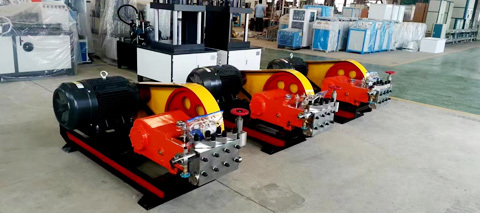What are the precautions for using an electric pressure testing pump?
Next, let's talk aboutElectric pressure testing pumpwhat precautions should be taken during use?

I. Preparation work
1. NewElectric pressure testing pumpWhen leaving the factory, in order to facilitate packaging, the hand-push handle is fixed on the pump head. When using, first install the hand-push handle.
2. Install the pressure gauge, facing the operator, for easy checking.
3. Install the power line, check the insulation and safety of the circuit, and ensure proper grounding.
4. Equip with a clean water tank to ensure sufficient water supply, connect the filter screen and suction pipe to the pump's suction port, and place it in the water tank.
5. Before use, check the oil level in the crankcase to ensure it is close to the oil line on the oil mark, and fill with AN46 oil.
6. Check whether the experimental medium is clean, avoid using wastewater containing sediment to prevent clogging of pipes and wear of the plunger, and ensure that the valves of each system are tightly closed to avoid problems.
7. Check whether the connecting parts and compression plugs can be tightened.
II.Electric pressure testing pumpStart action
1. Start the motor and check whether the empty vehicle can run normally (be careful to prevent the pump from running without water). The sound should generally be normal without abnormal noise, and the drainage should generally not have obvious shaking, then shut down.
2. Connect the test container to the pump's discharge port with a high-pressure hose. Before the experiment, large pressure containers (volume 10L~20L) should be filled with the experimental medium. For small pressure containers, to maintain pressure, a storage container with sufficient capacity (not less than 4L) should be configured in the experimental circuit.
3. Turn the overflow valve handle counterclockwise to open it, start the motor, and the pump begins to work normally. The tested container fills with water, and as the water fills, the pressure slowly rises. At this time, slowly turn the overflow valve handle clockwise until the desired experimental pressure is reached. After stabilizing, lock the overflow valve handle and maintain the pressure for the required time. After the same pressure experiment, there is no need to adjust the safety valve pressure.
4. Acceptance should be carried out according to the test requirements of the tested container. After the experiment, open the pressure relief valve to release the circuit pressure.
III.Electric pressure testing pumpPrecautions during operation
1. The experimental pressure must not exceed the rated working pressure of the pump.
2. During the pump pressurization process, if the pressure gauge pointer swings too much, and the diameter of the connecting pipe is too small, or the sample volume is too small, a pressure container with sufficient capacity should be equipped.
3. If the pressurization speed of the small pressure container is too fast, a step-by-step pressurization method should be used.
4. The pump should operate without noise.
5. The allowable temperature rise of the lubricating oil should be ≤45ºC.
6. If a leak is found in the pump during operation, work should be stopped immediately, and the pressure should be released for maintenance. It is not allowed to continue working in the case of a leak.
7. Be sure to check the sealing condition of the plunger. If there is a serious dripping phenomenon, adjust it at any time, but it is not allowed to adjust it too tightly.
8. When the ambient temperature is below 0°C, consider using antifreeze to prevent incorrect application.
Category tags:
Related Documents
Electric pressure testing pump manual series pressure testing pump production
Electric pressure testing pump selling points and characteristics
Details of intelligent pipeline pressure testing pump and electric pressure testing pump


